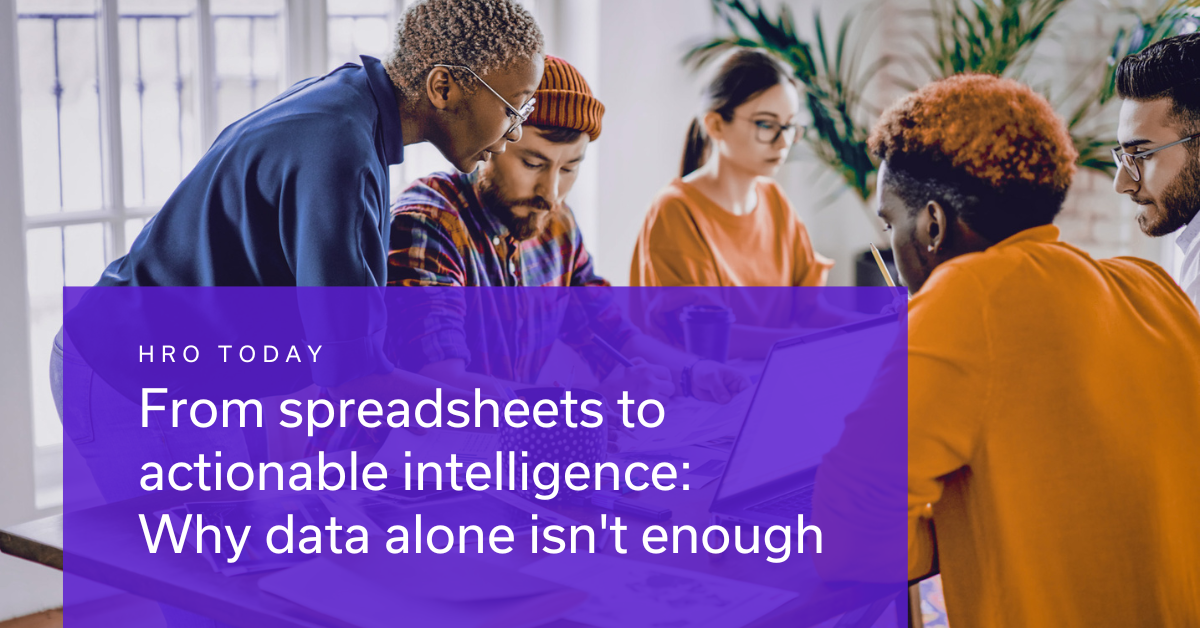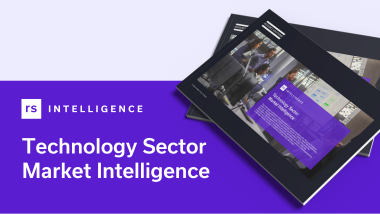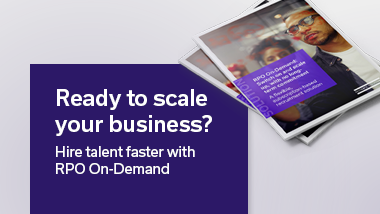From spreadsheets to actionable intelligence: Why data alone isn't enough
Why? Whether you work at an enterprise software company, boutique marketing agency, or a mid-size staffing firm, you probably have mountains of data to inform decisions and help explain the why behind every strategic decision.
And while HR intelligence tools are making it easier than ever to pull data, a recent HRO Today global survey of over 100 CHROs revealed that the usability of HR tech is a top concern. Data can be a powerful tool, but without actionable intelligence to go along with it, it's almost useless.
Dawn Sloan, SVP, Account Director and Duncan Ward, Global Director of RSConsultancy, joined the HRO Today podcast to discuss making data actionable and how talent acquisition leaders can use HR tech tools and data to inform decision-making.
Drowning in data
How many hires you made last year. The percentage of hires who came from underrepresented groups. How many minorities received promotions at your company over the past five years. There is data on all of that.
Data helps you understand your history and make informed decisions for the future. But is there such a thing as too much data? You have a wealth of data, but if most of it is inaccessible or too confusing to provide the actionable intelligence you need, it doesn't matter how much you have.
You know about the importance of data, but you need high-quality data that leads to actionable insights - not just numbers and spreadsheets. It starts with taking a moment to stop and think. What are you trying to do with the data? What questions are you trying to answer?
Data as a problem solver
You have mountains of data, but have you thought about what to do with it? As your requests and needs for data increase, take a moment to ask yourself why you need the data and what problem you're trying to solve with data.
In most organizations, the interpretation and analysis part of the data equation is missing. Duncan and Dawn suggest thinking about data to solve problems:
- What questions is this data helping me answer? You have so much information at your fingertips that you seldom know where to start. Establishing your goals for the data and understanding how it solves a specific problem can help you interpret the data. What are you trying to get out of the data? It's about analyzing the data to figure out where to search for solutions—not to tell you what to do.
- What is the data telling me, and what should I do with those insights? Once you collect the data, you need to interpret it to fully understand the story it's telling you and how you can apply those insights to your business. Remember, data needs to be simple, translatable to others in your organization, and usable so you can apply data to decision-making.
- How do I use the data to make data-minded decisions? You have analyzed the data and are ready to put it to use. But how do you use it to make informed decisions? How do you put it into practice? Focus on using the data to solve problems now and in the future instead of using data as a history lesson. Data should drive you forward.
Applying data to decision-making
Once you've dug into the data and visualized it in a way that helps you understand your problem and how data can help solve it, you can use it to make informed decisions.
Say your problem is high attrition rates and not enough qualified candidates to fill open positions resulting from attrition. You can visualize your data in a way that helps you understand where applicants are falling off in your candidate journey (if job seekers aren't accepting your offers) or what is causing sky-high attrition.
You can then use that data to drive communication and strategy to address this problem. And you can share the data with leadership to justify a shift in strategy or explain your decision-making.
Let's explore a few examples where data can drive impactful changes within your organization.
Staying competitive in the era of remote-first companies
When the world of work went remote during the 2020 pandemic, workers got used to a new, more flexible way of working. So when companies mandated a return to office post-pandemic (among other reasons), many workers joined the Great Resignation. And now, organizations without a remote work option are struggling to stay competitive.
Data can help you answer the question, "How do we stay ahead?" Using data to see where candidates drop off on their journey with your company can help you optimize your brand story. Data can also show you candidates' thought processes or the impact any changes you've made have had on hiring for non-remote roles.
Using data to drive DEI&B initiatives
Many organizations have invested heavily in branding campaigns and strategic hiring to create a more diverse and inclusive workforce. But is it working? Data can help you understand what works. It can also identify any trends (positive or negative) that you want to further across the organization or adjust your strategy to eliminate those trends.
Data best practices
Not sure how to approach data? We've got you covered!
- Ensure your data is credible. Where are you pulling data from (what sources)? Inaccurate or incomplete data doesn't tell the entire story, making it difficult to make informed decisions.
- Not all data is valuable. If your data isn't giving you information to work with or acting as a jumping-off point for your strategy, it likely isn't beneficial. Does it help solve a problem or answer a question? If not, you don't need to use it!
- Do you have old reports or data with no purpose? These can add to all the background noise and make conquering your data mountain even more insurmountable. Get rid of what no longer serves a purpose, instead focusing on the data that allows you to be actionable.
- Coach your team on the value of data. Your team might not know how to interpret data or understand how it plays into their role. Teach them how to use data and the value it brings to your HR team.
Six key points to remember:
- Improved accuracy: Data helps to remove biases and assumptions from decision making. By relying on data, decision makers can make more informed and accurate choices.
- Better insights: Data can provide insights into customer behavior, market trends, and other factors that can help guide decision making.
- Cost savings: By using data to inform decisions, businesses can avoid costly mistakes and make more efficient use of resources.
- Competitive advantage: Organizations that use data effectively can gain a competitive advantage over those that do not, by making better decisions more quickly.
- Increased transparency: By using data to support decisions, organizations can be more transparent about their decision-making processes, which can increase trust and confidence among stakeholders.
- Continuous improvement: Data can help organizations track their progress over time and identify areas for improvement, which can lead to continuous improvement and better outcomes.
Where Resource Solutions can help
Duncan briefly discussed RSIntelligence and how it can help companies understand:
- What should be top-of-mind
- What other companies do
- What's going on in the market
He explained organizations are looking for both an internal and external view of the market. And they want both forms of data to make more strategic and tactical decisions. With RSIntelligence, it's possible.
Our cloud-based talent intelligence platform sources data to give you unique market insights to make smarter, data-driven decisions that deliver impact.
Ready to dive into the data? Get in touch today.













